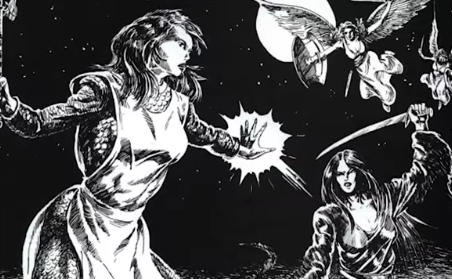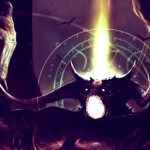In the universe of Dungeons and Dragons, it offers a whole world of opportunities for spellcasters to acquire an array of powerful spells. But with each level up requires much more thought into what is fitting for your character for situations both inside and outside combat.
1. Ray of Enfeeblement
Ray of Enfeeblement is a 2nd-level necromancy spell in D&D 5e that allows the caster to project a beam of energy that weakens the target’s physical strength. The target must make a Constitution saving throw, and if they fail, their attacks with weapons that use Strength are halved, and they deal half damage with them for the duration of the spell, which is one minute.
While this spell can be useful in certain situations, such as weakening a powerful melee combatant or reducing the damage output of a monster, it has limited application in combat and exploration making it one of the worst spells in 5e DnD. In addition, the spell requires the caster to make a ranged spell attack, which can be less reliable than other spells that require saving throws.
2. Jump
Jump is a 1st-level transmutation spell that allows the target to triple their jump distance for the duration of the spell, which is one minute. While this can be useful in certain situations, such as crossing a large gap or jumping over a hazard, it has limited application in combat and exploration.
In addition, the spell requires concentration, which can limit the caster’s ability to cast other spells or maintain other effects. Compared to other 1st-level spells that can provide more versatile and powerful effects, the Jump spell may be considered less effective in certain situations.

3. Gust of Wind
Gust of Wind is a 2nd-level evocation spell in D&D 5e that creates a strong blast of wind that travels in a line in a direction of the caster’s choosing. The wind extinguishes unprotected flames, pushes creatures and objects in its path, and can even force creatures to make a Strength saving throw or be pushed back 15 feet.
While this spell can be useful in certain situations, such as blowing away dangerous gases or smoke, pushing enemies off ledges or cliffs, or extinguishing fires, it has limited application in combat and exploration. In addition, the spell requires concentration, which can limit the caster’s ability to cast other spells or maintain other effects.
4. Antipathy/Sympathy
The Antipathy/Sympathy spell is an 8th-level enchantment spell that is not that powerful for what spell slot it’s worth. In terms of battle, it is practically inapplicable given its casting time of one hour and that is without concentration, leaving your magical caster on the battlefield just focusing on that spell.
Within that hour, there may still be a chance of the caster being halted from casting given the somatic, verbal, and material requirements. And even after successfully casting that spell the very effects of it only works within a short range of 60 ft, which may not be worth the time spent.
Even more so with whichever creature is affected by it, they are still more than able to break free from the effects if they simply succeed in a Wisdom saving throw.
5. Color Spray
Similar to the Sleep spell in some ways, the Color Spray has its own way of subduing opponents being faced during combat, specifically by blinding and stunning creatures. Although the effects are advantageous amid combat the spell has its limitations.
The effects can unfortunately only be benefitted for one round. The Color Spray spell is also limited to creatures with low hit points such as goblins and kobolds.
It may not be also great for crowd control as it only hits a 15-foot cone originating from the caster. So unless you are found face-to-face among many mobs grouped together, this spell slot could be spent elsewhere.
6. Detect Poison and Disease
The Detect Poison and Disease spell is very situational in the world of Dungeons of Dragons. In your future encounters in the campaign, it may only be useful if your food is poisoned or if there is an outbreak in your area.
Even when there are poisonous creatures in the area, encountering attacks that deal with a poison damage type is quite rare compared to other damage types. In an indoor situation, may not work as the spell description specifies, “It is blocked by 1 foot of stone, 1 inch of common metal, a thin sheet of lead, or 3 feet of wood or dirt.”
7. Witch Bolt
During combat against the enemy, the Witch Bolt spell can hit only one enemy within 30 ft. If you’re current campaign runs on tracking the material components to cast spells, finding “a twig from a tree that has been struck by lightning” may be a hard find.
Witch Bolt requires concentration and only deals damage once per turn, which may not be worth the spell slot. Just like any other concentration spell, if you desire to do anything else you would have to sacrifice the use of your Witch Bolt spell. And if you desire to do any more damage you would have to use up a higher spell slot to do so.

8. Tenser’s Floating Disk
If you are in situations that require you to transport heavy objects, then Tenser’s Floating Disk might be just for you. However, this spell may seem to be a bit lackluster given its many limitations. Though this creates a disk that can carry up to 500 pounds, the size of the disk itself (3 feet in diameter and 1 inch thick) may leave you hindered from what you could actually put on top of it.
The spell is left completely useless if you are found more than 20 ft of it and if the elevation changes to 10 feet or more when traveling. But one can not guarantee that whatever object is placed will remain on the disk without slipping off or being pushed off. Your best option is to perhaps invest in a carriage and horses or even a mule.
9. Animal Friendship
Animal Friendship is a 1st-level enchantment spell that allows the caster to convince a beast to become friendly towards them for the duration of the spell, which is 24 hours. While this spell can be useful in certain situations, such as calming down a wild animal or using it as a distraction or scout, it has limited application in combat and exploration.
In addition, the spell only affects beasts with an Intelligence score of 3 or lower, which means it cannot be used on more intelligent creatures such as dragons or humans.
Compared to other 1st-level spells that can provide more versatile and powerful effects, the Animal Friendship spell may be considered less effective in certain situations. However, it can be a useful tool for players who want to interact with the natural world or roleplay a character who has a special affinity for animals.
10. Protection from Evil and Good
Though it comes with a number of benefits against certain creature types, the Protection from Evil and Good spell may not be as applicable as you may think. With the Dungeons and Dragons universe being populated by mostly humanoid creatures, you may not be finding yourself and your party encountering the specified creatures of this spell’s description except in specific situations.
The Protection from Good and Evil spell may only come in handy in certain campaigns that have themes centered around aberrations, celestials, elementals, fey, fiends, and or the undead.
11. Sense Emotion
Feelings are an important aspect of the character, but sacrificing a spell slot to understand one’s emotion may not be that ideal. In the midst of combat, sensing one’s feelings may not be the most optimal action to take especially since it uses concentration.
What’s more is that there are limitations to that spell wherein Sense Emotions can only be used on one humanoid at a time and can technically only reveal one emotion of the target, which may seem to be a bit of a waste of a 1st level spell slot.
A high insight check made by you or a fellow party member who’s proficient along with some needed help might do the trick. But if you do want to consider an alternative, the Detect Thoughts spell can more than suffice in understanding what a certain character is going through.
Final Thoughts on the worst spells in 5e
Choosing a spell is a step toward becoming a great spellcaster. With more levels comes with more choices to consider into preparing or expending a spell slot, it may be overwhelming to come down to one or a few.
But always take in mind that it’s always helpful to consider spells that are both effective and thematically appropriate for your character, and avoid spells that might be less useful in practice.
Remember, the goal of Dungeons and Dragons is to have fun and tell a great story, so don’t be afraid to experiment with different spells and playstyles to find what works best for you and your group.
